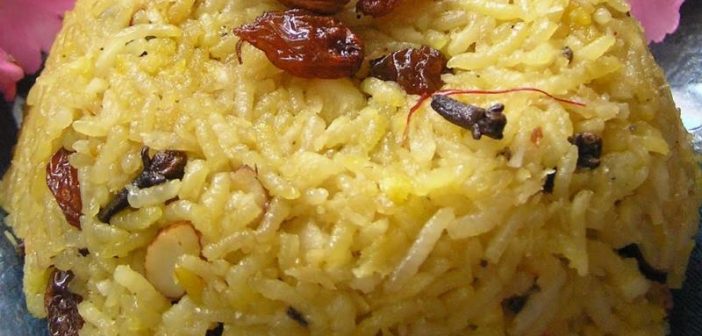Narali Bhat, a delicious coconut-flavored sweet rice dish, holds a special place in Maharashtrian cuisine, particularly during the Raksha Bandhan festival. This dish, rich in tradition and flavor, is especially popular in the coastal regions of Maharashtra. Its unique blend of ingredients and the cultural significance attached to it make Narali Bhat an integral part of Maharashtrian festivities.
Origins and Historical Significance
Narali Bhat traces its roots to the coastal areas of Maharashtra, where coconut is a staple ingredient due to its abundant availability. The name “Narali” comes from “Naral,” the Marathi word for coconut, which is the key ingredient in this dish. Historically, coconuts have held religious and cultural significance in Hindu rituals, often symbolizing prosperity and purity.
The origins of Narali Bhat are intertwined with the agricultural practices and trade in the Konkan region. Coastal Maharashtra has a long history of trade with other regions via the Arabian Sea, where coconuts were not only an essential crop but also a significant trade item. Over time, the use of coconut in various regional dishes became a symbol of coastal Maharashtrian culture.
Traditions and Rituals
Raksha Bandhan, or Rakhi Purnima, is a festival celebrating the bond between brothers and sisters. In Maharashtra, this day also coincides with Narali Purnima, a festival marking the beginning of the new fishing season. Fishermen offer coconuts to the sea, seeking the blessings of the sea god, Varuna, for a safe and bountiful fishing season.
Narali Bhat is traditionally prepared as an offering during Narali Purnima, symbolizing the importance of the coconut in the lives of those living in coastal regions. The dish is made as part of the festive meal shared by families after the rituals are performed.
Ingredients and Preparation
The preparation of Narali Bhat is a testament to the simplicity and richness of Maharashtrian cuisine. The key ingredients include:
- Rice: Traditionally, short-grain rice is used for its texture.
- Coconut: Freshly grated coconut is essential for an authentic taste.
- Jaggery: Provides the sweetness that characterizes the dish.
- Ghee: Adds richness and enhances the flavor.
- Spices: Cardamom, cloves, and saffron are commonly used to add aroma and depth to the dish.
- Dry Fruits: Cashews, raisins, and almonds are often added for texture and added richness.
The dish is prepared by cooking the rice and then mixing it with a mixture of coconut, jaggery, and spices. The slow cooking process allows the flavors to meld together, creating a fragrant and flavorful dish that is both sweet and mildly spiced.
Cultural Significance and Symbolism
Narali Bhat is more than just a sweet dish; it is a symbol of the cultural heritage of Maharashtra. It embodies the region’s connection to the sea and the central role of coconut in both daily life and religious rituals. The dish also reflects the importance of Raksha Bandhan as a festival that strengthens familial bonds and celebrates the spirit of sharing.
The offering of coconut to the sea during Narali Purnima and the preparation of Narali Bhat at home create a harmonious blend of devotion and celebration. It is a reminder of the interdependence between humans and nature, particularly for those who rely on the sea for their livelihood.
Variations Across Regions
While Narali Bhat is a staple in coastal Maharashtra, there are variations in the recipe depending on the region and family traditions. Some variations include:
- Addition of Saffron: In some regions, saffron is added to give the dish a golden hue and an extra layer of flavor.
- Use of Different Sweeteners: While jaggery is traditional, some variations use sugar or a combination of both to adjust the sweetness.
- Incorporation of Fruits: In some households, seasonal fruits like ripe bananas or pineapples are added to the dish for a fruity twist.
Each family may have its own version of Narali Bhat, passed down through generations, making it a dish rich in personal and cultural significance.
Modern Adaptations
In recent years, there have been modern adaptations of Narali Bhat to suit contemporary tastes and dietary preferences. Some of these adaptations include:
- Healthier Versions: Using brown rice or quinoa instead of white rice for a healthier alternative.
- Vegan Options: Replacing ghee with coconut oil to make the dish vegan-friendly.
- Minimalist Versions: Simplifying the recipe by reducing the number of spices and dry fruits while maintaining the core flavors.
These adaptations allow Narali Bhat to continue to be enjoyed by a broader audience, ensuring that the tradition evolves with the times.
Conclusion
Narali Bhat is more than just a festive sweet dish; it is a celebration of Maharashtra’s rich cultural heritage and the deep connection between its people and the sea. The dish’s origins, ingredients, and traditions highlight the importance of maintaining cultural practices while also adapting them to modern lifestyles.
As families come together to celebrate Raksha Bandhan, the preparation and sharing of Narali Bhat serve as a reminder of the enduring bonds of love, tradition, and community. Whether enjoyed in its traditional form or with a modern twist, Narali Bhat remains a beloved part of Maharashtra’s culinary landscape, especially during the joyous occasion of Raksha Bandhan.





